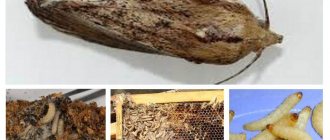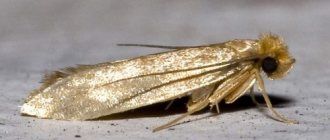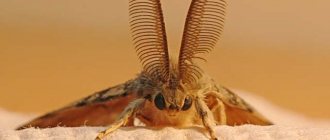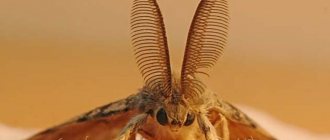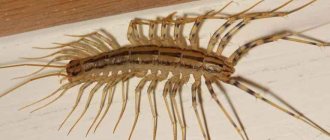general characteristics
The moth belongs to the order of lepidopteran insects that develop their activity at dusk. Adults do not cause any harm. They just reproduce and lay eggs. They do not have a proboscis, since the oral mechanism is equipped with powerful jaws capable of crunching the bones of any plants and feeding on their seeds.
What does a mole look like:
- The pest is very similar in appearance to butterflies.
- But these winged colorful insects feed on the nectar of flowers, having a long proboscis. An adult moth is not even able to digest food. She only breeds offspring. She accumulates all her energy while in the state of a caterpillar.
Therefore, you should not waste energy fighting adult moths: moth larvae feed on things and furniture.
Insect purpose
Why do you need cabbage or other moths? In addition to the disadvantages, it also has various advantages.
What are the benefits of moths? First of all, such an insect (in particular, the wax moth) is a raw material for the manufacture of effective medicines for tuberculosis, various cardiovascular ailments, lung diseases, or for stimulating the immune system.
In addition, various wax moth preparations increase a person’s immunity and physical activity, and also regulate energy metabolism.
Lifespan
Hardly anyone thought about how long a moth lives. She cannot be considered a long-liver. The total lifespan of a winged individual is from 2 to 4 weeks, depending on the type of moth. Insects move and fly little. The main activity occurs at dusk, as they are good prey for any predator.
To reach sexual maturity, the moth must go through certain stages of development:
- the female lays eggs twice a year, from which caterpillars appear two weeks later, the temperature is +20 degrees, which is favorable for the development of offspring;
- Moth larvae form a nutritious cocoon around themselves, where they develop for 3-10 months.
If we consider the full life cycle of an insect, then moth eggs go through a long stage of development to the state of an adult, all this time feeding on the materials and products in which they live.
Reasons for appearance
Of course, the question of where moths come from worries everyone who has encountered such a problem. There is no definite answer, but still the most likely reasons for encountering a pest in your own home are:
- Flew through the window. If a lone butterfly has just entered your home, destroy it immediately. The female will lay eggs, and then the troubles will only increase.
- Brought with things. Since this parasite finds food for itself in anything (cereals, dried fruits, fur coats, carpets, books, etc.), the probability of being delivered to a clean home with some things or products is very high.
- Brought on by the fur of a domestic animal. If your pet walks outside for a long time, moths can lay eggs unnoticed in its fur. Further in the house they fall on the carpet or furniture, and then the usual development cycle.
- The agricultural moth “destined” ends up in warehouses and storage facilities along with contaminated cereals and vegetables.
Varieties
Types of moths
There are about 3,000 representatives of these insects, and only a few dozen of their varieties are pests. They don't differ much in size. The main differences are in color, habitat, body and wing configuration. The following types of moths are best known to man:
- household: clothing, food, furniture, fur coats, carpet, wool;
- in the wild: ermine, foxglove, chestnut;
- in agriculture: cabbage, potato, wax, fruit, grain.
Interesting!
In nature, the life of a moth depends on weather conditions and the time of year. The man offered her more comfortable living conditions: constant warmth and food in abundance. Therefore, everyone knows from their own experience in dealing with this scourge how moths multiply in human habitation. It reproduces all year round, and the caterpillars of these apartment lovers go through all stages of development faster than their counterparts living in natural conditions.
Moths can get into an apartment in a variety of ways. Food or potato representatives most often enter the home through food products that are stored in warehouses for a long time. They lay eggs directly in the packages. The wood pest enters through ventilation ducts.
Is this parasite dangerous for humans?
Unlike other various parasitic insects, moths do not cause much harm to a person and his apartment if it is removed from the house in time. This moth often destroys only certain clothes.
Certain types of moths (for example, the cereal moth) damage food products such as cereals, chocolate and nuts. However, this type of moth does not cause significant harm to humans.
The only disadvantage of such a parasite is the contamination of food, as well as its rotten appearance.
Why are moths dangerous?
It harms a person in the following ways:
- spoils the appearance of food;
- contaminates dishes;
- destroys clothes;
- causes discomfort.
Such a lepidopteran parasite is dangerous to human health only if he does not get rid of it in a timely manner.
Video
Extremely dangerous! About potato moth
Clothes moth
Clothes moth
It is a small straw-colored insect up to 9 mm in size. This pest cannot appear just like that. He gets into the house with things that are bought in the store. The larvae are already hiding in clothes or furniture. After getting into the apartment, they simply begin to develop intensively and expand their habitats, settling on other wardrobe items in the clothing closet. The larvae especially love products made from natural materials, wool, and fur.
In several other ways, clothes moths can appear in the house:
- through open vents and windows;
- ventilation communications;
- from neighboring apartments.
In order not to breed malicious tenants in your apartment, it is necessary to install nets on window openings and ventilation vents.
Important!
Clothes moths can destroy not only old, but also new clothes. Worn items and second-hand furniture are more attractive to this species, as they make the path to the food source easier.
To prevent clothes moths from infesting your home, you must carefully inspect all seams, fur items, and shoes purchased at retail outlets. How to get rid of clothes moths if flying butterflies do appear:
- It is necessary to spray the products with special aerosols, wash them in hot water or treat them with steam.
- You can take things out into the sun and fry them for several hours.
- After processing, store in special tightly closed duffel bags.
How to store things and products to protect them
- Before storing seasonal clothing, wash and iron it, clean large items and fur items, shake out and air.
- Store fur coats and outerwear made of wool in thick paper bags with anti-moth tablets inside. You can spray an aerosol anti-moth spray into the bag.
- Purchase special covers impregnated with anti-moth agents. They will effectively protect clothes from uninvited vandals.
- It is convenient to store small items in vacuum bags. Cover your clothes with anti-moth tablets or canvas bags with fragrant herbs.
- Wrap things in fresh newspapers; moths cannot stand the smell of printing ink.
- Store cereals, sugar, flour and other bulk foods in glass or metal containers with tight-fitting lids. Cardboard boxes and plastic bags are not a barrier for moths.
To preserve things and products and prevent pests from appearing in the house, create unacceptable conditions for their existence.
Wool moth
This species is quite widespread. It lives not only in apartments and warehouses, it can be found in mills and museums. The larvae eat dirty clothes and dust. Therefore, you can hear the name dust moth. The larva is not able to completely eat clothing, but spoiling it well is not a problem. The wings can have a span of up to 2 mm. The front ones are painted light brown, with a golden-pearl tint. The hind wings are distinguished by a beige color, and there is a fringe along their edges.
On a note!
This species is very prolific; the female is able to lay up to 90 eggs during her very short life.
Appearance
What does 1 common mole look like? This moth has a yellow color - gray or dark. A red tint is sometimes visible on the body of this insect.
Such a parasite has 2 pairs of shiny wings that shimmer in the sun. A fringe is visible along its edges. The span of the front wings of such a moth is 9–18.5 mm. The hind wings are more uniform in color and smaller in size.
The chest of such a small pest is brown on top and light yellow and shiny below.
The male of this insect is smaller than the female, and after mating with the female and fertilizing her, he quickly dies. The female of this small pest lives for about 1 month.
Furniture moth
This type of moth is light yellow in color with golden wings. The female lays up to 300 eggs within a half-month. The larvae begin to move actively only when they gain access to adequate nutrition. The moth lays its eggs in crevices of wood, under furniture upholstery, eating it. Every homeowner dreams of getting rid of moths in their apartment. Indoor moths are afraid of sunlight, so the larvae begin to hide in cocoons. Unfavorable conditions prevent caterpillars from developing and parasitizing.
Furniture moths are similar in appearance to a food pest; it is quite difficult to distinguish them. If you look at a photo of a moth, only a specialist can recognize whether this individual eats wool or cereals.
Natural "camouflage"
Nature gave such an inconspicuous color to moths for a reason. First of all, because the earthy shade is an excellent protection and allows you to avoid an unpleasant encounter with a hungry predator. An interesting fact is that representatives of different species of moths living in a particular environment acquire colors in accordance with its conditions. For example, the development of moths of forest species is more characterized by a greenish tint, while others are more characterized by the color of the bark of trees, which are more abundant in this area.
But science has become aware of an even more unique phenomenon, a property that only very few representatives of the insect world can boast of. It has been observed that in urban areas where there is heavy soot pollution, some species of moths actually become darker in color than insects of the same species living in less polluted areas.
Another effective form of camouflage is the shape that the insect takes on when at rest. Species that live primarily in tree crowns, as a rule, do not fold their wings at all in order to be more like dry leaves, while “grass” ones actually extend their wings into a line so that they cannot be distinguished from a blade of grass. Not least important is the flight strategy of the moth.
Few of these species fly straight and slowly. Many of us have observed house moths flying around in such a way that it becomes difficult to catch them. Light excites the insect, forcing it to be even more active, so the closer the light source, for example, a light bulb, the faster the moth will fly and the more chaotic at first glance its direction vector will be, which most often becomes circular.
An effective form of defense that other flying insects could take a few lessons from the moth is mimicry. Mimicry is the ability of a living organism to simulate the appearance of a larger or more threatening creature. This form of defense is used both by caterpillars with tails that look like the large head of a poisonous snake, and by adult individuals, whose war-spotted coloring on the outer surface of their unfolded wings scares off even large birds. Mimicry is also characteristic of some species of butterflies.
food moth
Food moth
Larvae of this species prefer to feed on grocery products, so they will not touch wool or fur. They are omnivorous for foods that contain carbohydrates. The most popular characteristics for larvae are:
- flour;
- cereal;
- seeds;
- pasta;
- cookie;
- dried fruits;
- nuts;
- candies.
Their presence can be detected by molded lumps of cereal and cobwebs on the grains. If tunnels are made in pasta, then this is a sure sign of the presence of parasites. Food moth larvae can be found wherever there is free access to food.
Important!
Moth caterpillars can even cope with plastic bags, so it is better to store food in metal, glass or wooden packaging.
The reproduction and development of the larvae of this species is faster than that of the clothes one, since the food of food representatives of insects is more varied and nutritious. If you find larvae in food, you need to throw them away immediately and try to get rid of food moths in the kitchen as quickly as possible. If the contamination is small, then the grains can be sorted, the flour sifted and everything calcined in the oven at a temperature above +50 degrees.
Repellents
The products included in this group are recognized as absolutely safe for humans. The disadvantage of these products is that they destroy or repel only butterflies and have no effect on worms.
They are produced in the form:
- sticky trap tape that attracts butterflies;
- plates that repel pests from products.
For this reason, a food moth trap, like a plate, serves more as a means of prevention than active pest control.
Wax moth
This insect is a threat to beekeepers. When settling in hives, caterpillars eat honey, bee bread and bee larvae. If there are a lot of pests, they can damage the protective layer of the hives, which prevents the bees from freezing in the cold.
Interesting!
Man has learned to use moth caterpillars for his own purposes. Since fermentation in the moth's stomach produces a substance called wax moth extract, which can destroy pathogenic bacteria, people have begun to use it as a natural remedy to treat many diseases. The extract-based preparation is known as wax moth tincture.
Cleaning the premises
Experts recommend not limiting yourself to washing kitchen cabinets and shelves, but carrying out a general cleaning of the entire room after a complete audit of food supplies.
All furniture, floors and walls should be thoroughly washed with a solution of laundry soap, and then wiped with vinegar diluted with water. The gaps between kitchen furniture and walls need to be vacuumed, as well as the spaces between cabinets and cabinets.
Adults can hide under the windowsill, on the ceiling or on the wallpaper. Therefore, it makes sense to use chemical pest control agents after eliminating spoiled products and general cleaning of the premises.
Potato and cabbage moth
These pests can destroy crops. Their difference lies not only in color, but also in the type of food that they prefer. Dirty gray moth, settling in potato tubers, damages the integrity of the fruit, and in the spring, during sowing, it again enters the soil.
The cabbage representative looks like a straw when its wings are folded. It flies poorly, but multiplies quickly, damaging the juicy young leaves of the vegetable. As a result of such proximity, the cabbage crop may die.
Agricultural pests
Some types of moths cause serious damage to agricultural crops. Cereals are especially affected: wheat, rye, corn, oats, barley. Even a small colony of pests, multiplying quickly, can destroy a significant part of the crop.
grain moth
The grain moth is a yellowish-gray moth with a bronze tint, with a wingspan of 11 to 17 mm. Lays eggs on grains. The hatched larva gnaws through the grain shell, penetrates inside, where it grows, feeding on the inside of the grain. By the time of pupation, the grain is already hollow. This species can damage both grain crops growing in the field (most often in regions with warm climates) and grain harvested for storage.
Cereal
Rye moth
The rye moth looks like a small yellow-brown butterfly. Lays eggs on winter seedlings and wild cereals. The larvae live in the stems, gnawing out their core. Prefers the more tender part located under the ear. Due to the damaged stem, the ears gradually dry out.
Enemies of the bee moth in nature
The enemies of the great bee moth are hymenoptera insects: bees, wasps, bumblebees, whose hives are damaged by moths.
Bees are able to fight pests on their own. This works especially well in strong families. During repair and cleaning of cells, worker bees tear apart and eat young larvae of the large wax moth. To extract them from the wax, they gnaw off parts of the affected honeycomb. Bees throw older larvae out of the hives whole. In cracks and crevices they seal butterfly pupae with propolis. And adults who fly into the hive are grabbed by the legs and wings and are not allowed inside. But 2 hours after dark, bee colonies stop defending themselves and do not notice the fires. If you knock on the hive at this time, the bees will become excited and kill the arriving butterflies. But such a protective reaction is not observed in all bee families and not in all bee species. The honey bee cleans the hive better and is therefore more resistant to moths, while the average Indian bee is less clean and is more susceptible to butterflies. Honeycombs in colonies of Italian bees are even less susceptible to caterpillar infestation.
Bee moths are destroyed by the nematodes Heterorhabditis bacteriophora, parasitic egg-eating parasites: Trichogramma, Braconidae; Tahina flies, or hedgehog flies (lat. Tachinidae), butterflies are caught by insectivorous bats. Weakened moths often die from infection caused by the opportunistic yeast Candida albicans.
Folk methods of struggle
The use of ancient methods of pest control is based on the fact that moths are repelled by pungent odors. Therefore, to protect food supplies they often use:
- garlic;
- laurel leaf;
- tobacco;
- citrus peels;
- aromatic herbs and spices.
Fragrant leaves of rosemary, mint, lavender, as well as cloves, allspice, and bay leaves are placed in cabinets and containers with bulk products.
Periodically, it is recommended to wash grocery storage areas with diluted vinegar.
Preventive measures
As part of preventive measures, it is recommended to follow a few simple rules.
- You should not purchase large quantities of grocery products for future use, especially flour, cereals and pasta.
- When purchasing, you should carefully check the strength of the packaging and the condition of the product. The presence of fine dust and debris may be a sign of infection.
- After purchasing, it makes sense to pour the product into sealed containers for storage.
- Aromatic herbs, spices and garlic cloves on the shelves will repel butterflies from the products.
- Regular ventilation of the room will also serve as a useful preventative measure, since moths do not tolerate drafts well.
- It is effective for timely detection of moths to regularly inspect food supplies and clean cupboards.

